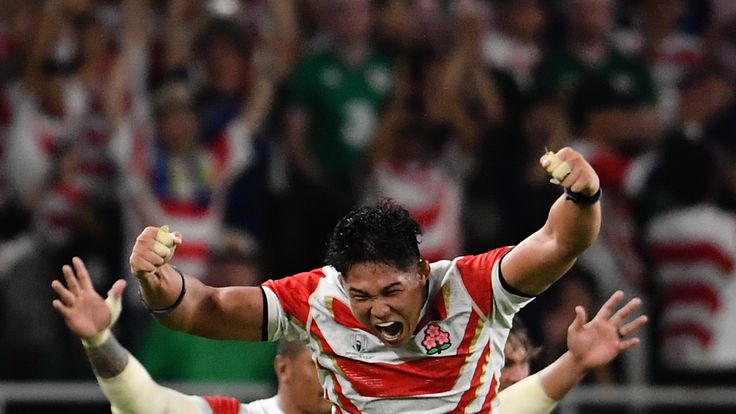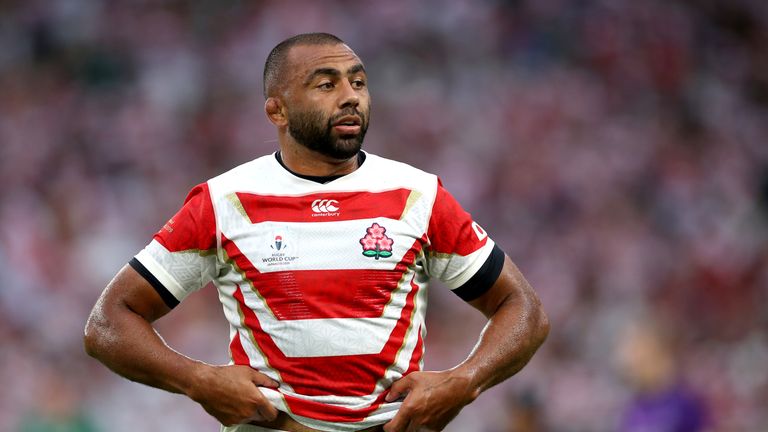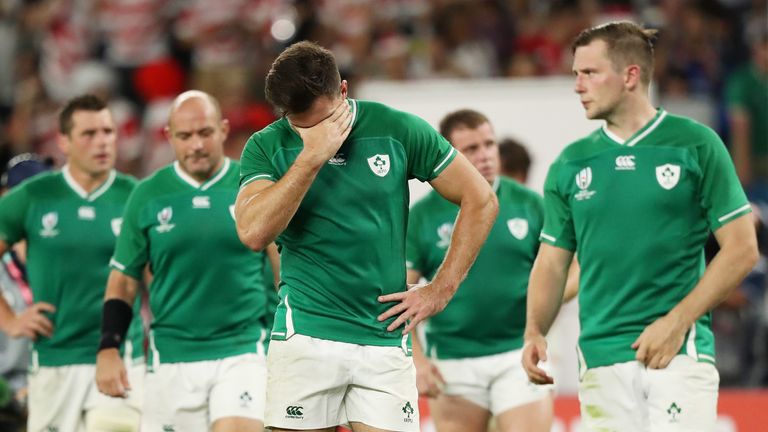How did Japan beat Ireland in Rugby World Cup 2019 Pool A?
We dissect one of the Rugby World Cup's greatest ever shocks as Japan overcame Ireland

Sunday 29 September 2019 09:56, UK
If Japan's miraculous victory over South Africa in Brighton four years ago was a bolt completely from the blue, Saturday's 19-12 World Cup win over Ireland at their home tournament was no less unexpected, or extraordinary.
Indeed Joe Schmidt's Ireland are famed for the control and pragmatism with which they play the game, and if they required any warning as to Japan's danger, they need only have rewatched that memorable Test from 2015, or caught the premiere of 'The Brighton Miracle' - the film made starring Temuera Morrison.
This was a free hit for Japan. Up against the side which came into the World Cup as No 1 in the world - albeit courtesy of the near farcical ranking system in effect within the sport - and one which put Scotland to the sword six days ago in the rain of Yokohama.
Japan had been less-than inspiring in their opening win over Russia, while they still had a final pool stage Test with Scotland to come - predicted to be a quarter-final shootout.
Ireland's record against Japan before this Test was seven wins and no defeats. Two years ago, they toured the country with a host of front-liners missing on British and Irish Lions duty, and registered totals of 50 and 35 points in two comprehensive successes - the first occurring in the same venue as Saturday's World Cup Test: Shizuoka Stadium.
So how did Japan pull off another monumental World Cup upset?
The turning point
Ireland came into this one in a confident mood having emphatically beaten Scotland 27-3 in their Pool A opener, and also having never lost to a Tier 2 nation at a Rugby World Cup.
That record appeared under little threat during the first half when well-constructed Garry Ringrose and Rob Kearney tries - both created by Johnny Sexton's stand-in fly-half Jack Carty - had Ireland cruising at 12-3 in front.
They had been clinical in the red zone, physical in the carry, good in the air and the first scrum of the game had brought a dominant penalty from the pack on 18 minutes.
One moment, with four minutes of the first period remaining, seemed to change all that. Ireland were probing by the Japan 22, and were handed an attacking scrum when Japan lock Luke Thompson stripped the ball forward in the tackle.
In a wonderful position to execute a strike-play - an area where Schmidt teams are at their most effective - Ireland would have been aiming at least to draw a scrum penalty and chance for 15-6 lead before the break; at best to work a try and 19-6 advantage.
With the ball at No 8 CJ Stander's feet, Ireland looked likely to keep it in and shove for the penalty, but the Japan pack surged forward - likely as a result of loosehead Keita Inagaki illegally boring in on Ireland tighthead Tadhg Furlong on the angle - gained ascendancy and forced the decision against the head from referee Angus Gardner.
The reaction from the crowd was as if the Blossoms had scored a try and the belief such a moment gave the Japan players was visible.
Two minutes later Yu Tamura kicked his third successful penalty after Josh van der Flier became trapped in a ruck, and the deficit was back to 12-9.
From being in a position where the Test could have been taken away from them and Ireland out of sight, they were within touching distance. The response was palpable as Japan continued playing two minutes into dead time at the end of the half as their confidence grew immeasurably.
In the end, Ireland were relieved to head in at half-time with a slender 12-9 lead, and would face a vastly different Japan for the rest of the match.
Ball retention and speed of service
If there is one area in which Japan excelled to the point at which Ireland could find no way back, it was their speed of ball at the ruck and retention of possession.
Schmidt bemoaned the fact Japan clear the ruck deeply, making it difficult to contest and slow down, but if Ireland struggled in this facet against the Japan pack, what chance against the All Blacks or Springboks?
Starting scrum-half Yutaka Nagare and replacement Fumiaki Tanaka kept the tempo of Japan's attack phenomenally high, and the Blossoms had the fitness to keep up.
The ruck speed was lightening and Ireland couldn't handle it. Once they were behind, it became even more of a pivotal factor, and Japan's application was outstanding all day.
As mentioned above, Ireland are at their most threatening off set-piece, but Japan only allowed them two lineouts for the entire second half as Schmidt's side, remarkably, failed to score a second-half point.
The men in green struggled enormously to get the ball back off Japan, while their own breakdown operated at nowhere near the pace Japan's was.
As a consequence, Ireland were roped into a loose, unstructured game of offloading - not their usual mantra at all - and as the game wore on, looked increasingly rushed and panicked as Japan grew in vigour and self-assurance.
Defensive masterclass
A key stat coming out of this one was missed tackles - as Ireland finished with some 20 missed tackles over the 80 minutes.
Japan, by contrast, missed just over half that amount and repelled wave after wave of Irish attack, making their northern-hemisphere counterparts look distinctly blunt going forward - and in moments during which the visitors were most desperate to break through. It was highly impressive.
Ireland failed to breach the gain-line as Japan attacked the tackle area in numbers, and gave everything they had in terms of energy and power.
Ireland still had chances within the Japan 22 - a side with their quality is always going to - but the key defensive moments went Japan's way as Kazuki Himeno earned a huge breakdown penalty mere metres from his own try-line with 15 minutes left and the lead four points.
The defence was typified by second row James Moore, who made 23 tackles, missed none and did not give away a single penalty either.
It was effort, and then some from Japan.
Discipline
Another central area to this win was the penalty count, and in this area, Japan adapted to referee Gardner far, far better than Ireland did.
Japan conceded six penalties but just one in the second half and three defensively, while Ireland were pinged in crucial situations - seven of nine in defensive areas to be exact.
Gardner's interpretation at the ruck - or lack thereof - benefited Japan as a host of side entries, hands in the ruck and offsides seemed to be missed.
By contrast, Ireland kept giving away decisions for offside and going off feet, and they were punished by the boot of Tamura.
One incident with 11 minutes left saw flanker Lappies Labuschagne go off-feet and play the Ireland nine Murray under the nose of the referee, but fail to get penalised. Seconds later Ireland were blown up for a forward pass.
The critical moments went the way of the home side, but Japan earned that right by working as hard as they did and Ireland should have played in a way which took the referee out of the game. Or adapted to him as Japan did.
Indeed, they had concerns about Gardner even before kick off as Schmidt commented: "Obviously last time we had Angus [Gardner] it wasn't great for us.
"We didn't play particularly well but we didn't feel we got a lot of the rub of the green either.
"I think if you look back at the scrum, we actually went straight through the middle of the Welsh scrum to get a turnover ball very early in the game.
"And then when they ran around the corner we got no receipt [of penalties] from that and they were given penalty rewards, which was incredibly frustrating."
Whatever Schmidt and his charges' plan was for the ref didn't work, and all they can hope is that they avoid Gardner in the future.
The Blossoms and Jamie Joseph did their research on him and thrived in the heat of a World Cup Test match.
So what now...?
With two wins from two, Japan currently sit in charge of Rugby World Cup Pool A, with games against Samoa (Saturday October 5) and Scotland (Sunday October 13) to come.
Should Japan win both, they will top the Pool, qualify for a first ever quarter-final and in all likelihood face old adversaries the Springboks.
Ireland must hope Japan slip up in order to top the pool and avoid New Zealand in the knockouts, while Scotland will - providing they beat Samoa on Monday - earn a quarter-final place instead of Japan should they beat them in Yokohoma in the final pool stage fixture of the World Cup.
The Scots will have a a four-day turnaround ahead of that massive encounter though, while Japan will have eight days to prepare.
As the only side in history to win three pool games and fail to make a quarter-final back in 2015, Japan will dearly hope to avoid a similar scenario this time around.
A nation believes, and it is now all in their hands.


















